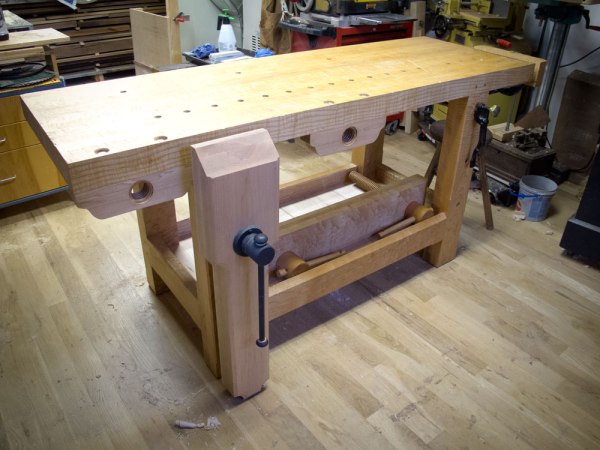
There is only so much book and video editing I can do before my head starts to feel like a wheel of gouda. Lucky for me, I can go to the shop at any point (What are they going to do, fire me?) and clear up my digital daze.
This weekend, I’ve been working on a couple of long-time-coming personal projects. One is a 16th-century square that I’ll be writing about later this week. The other project has been to finish my Holtzapffel workbench, which I began building almost seven years ago.
Today I finally added a shelf, which is made from maple that has been shiplapped and beaded. The shelf pieces are nailed to four ledgers that are screwed to the stretchers between the legs – pretty standard stuff.
For the most part, I use cut nails in my shop because they hold better and look better.
I was reminded of this today because the nails were a bear to drive. That’s because I was nailing through maple and into old yellow pine. Also, I had correct-sized pilot holes for my 6d nails.
What is a “correct pilot hole?” It’s a hole that doesn’t allow any of the boards to split and that permits the nail to really wedge everything tight. If your boards are splitting, you are doing it wrong. If the nails are easy to drive, you are (again) doing it wrong.
Here’s how I determine the pilot hole for any given situation.
1. If I’m nailing soft white pine, I do an experimental joint to see if I can get away without a pilot hole. Sometimes I can. Great success!
2. Otherwise, I select a drill bit diameter that matches the diameter of the tip of the cut nail. For many furniture nails in casework, this is 3/32” or so.
3. Then – and this is important – I make a test joint with the pilot hole in the same material I’m going to nail and with the pilot the same distance from the end of the board.
4. And then – and this is even more important – I drill the pilot hole to a depth that is only two-thirds the length of the nail. (For example, if the nail is 1-1/2” long, the pilot should be 1” deep.) If your pilot is the full length of the nail, then the joint is too weak. The nail should be difficult to drive. Conversely, if your pilot is too shallow, the nail is likely to bend before it reaches full depth.
I didn’t make this stuff up. This is information in the old books. Ignore it at your own peril. Or use drywall screws.
— Christopher Schwarz